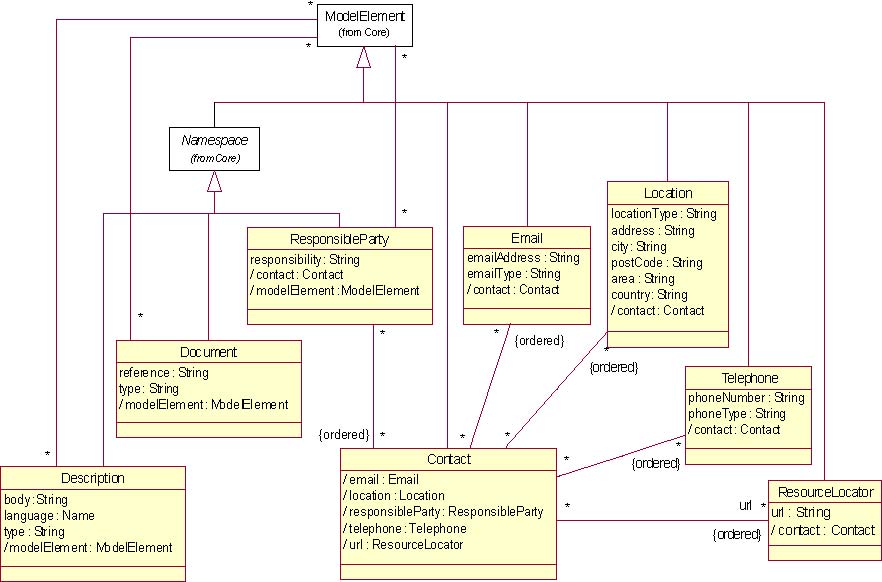
| Previous | Table of Contents | Next |
The Business Information package depends on the following package: org.omg::CWM::ObjectModel::Core
The Business Information Metamodel provides general purpose services available to all CWM packages for defining business-oriented
information about model elements. The business-oriented services described here are designed to support the needs of data
warehousing and business intelligence systems; they are not intended as a complete representation of general purpose business
intelligence metamodel.
Business Information Metamodel services support the notions of responsible parties and information about how to contact them,
identification of off-line documentation and support for general-purpose descriptive information. Three CWM classes “anchor?
these services: ResponsibleParty, Document, and Description, respectively.
The metamodel is shown in
Figure 5-2
.

Figure 5-2 BusinessInformation metamodel
To aid in representing the diversity of organizational structures and documentation relationships that may be encountered
in a business intelligence system, the metamodel provides robust relationships between the anchor classes and every model
element in the CWM metamodel. The necessary robustness is achieved in several ways.
First, every CWM model element may have zero or more instances of each anchor class associated with it. This means, for example,
that a single Description instance can be used to describe many different model elements. Conversely, a single model element
may be described by many different Description instances. Likewise, Document and ResponsibleParty instances can be associated
in completely ad hoc ways with any model element. Extending this idea means, for example, that Description instances could
be used to further describe ResponsibleParty and Document instance, if needed.
Second, because they are Namespaces, the anchor classes can be organized into hierarchies using the ElementOwnership association.
For instance, an organizational structure can be represented by a hierarchy of ResponsibleParty instances. Also, the internal
structure of a document; that is, its chapters, sections, subsections, etc. might be represented by a hierarchy of Document
instances.
Finally, instances of the three anchor classes can be associated with any model element (via their individual associations
to ModelElement) and referenced by multiple instances of any of the three anchor classes. Because of the strong containment
of the ElementOwnership association in the ObjectModel, anchor class instances can only participate in one hierarchy, but
there are no restrictions preventing anchor class instances embedded in a hierarchy from referencing, or being referenced
by, other model elements (even other members of the same hierarchy).
To illustrate some of the ways that the metamodel can be used, Figure 5-3 shows a
simple document hierarchy with responsibility assignments and descriptive comments (boxes represent instances of metamodel
classes and labelled lines represent metamodel associations connecting instances). In the example, the product plan document
for the Widget product is composed of three subplans: a marketing plan, an engineering plan, and a resource plan. The relationships
between the subplans documents is shown as a hierarchy with the product plan owning the three subordinate plans via the ElementOwnership
association. Each part of the plan is assigned to a responsible party using the ModelElementResponsibility association. Finally,
Description instances are used to record roles for the responsible parties.
: ModelElementDescription Product Manager :DescriptionResponsibleParty
"Widget" : ElementOwnership Name

body= "Ensures subplansare ModelElementResponsibilitywritten" : String
Product Plan : DocumentDescribes Product : Document Class
Marketing Plan : Engineering Plan : Resources Plan :Document Document Document
ModelElementResponsibility ModelElementResponsibility ModelElementResponsibility
VP Marketing : Architect : CFO :ResponsibleParty ResponsibleParty ResponsibleParty
ModelElementDescription ModelElementDescription ModelElementDescription
: :
:
DescriptionDescriptionDescription
body ="Approves body ="Develops body= "Builds financial marketing plan" : String engineering plan" : String model" : String
Figure 5-3 Document hierarchy with assigned ResponsibleParties
Similar robustness is provided for structuring relationships between ResponsibleParty instances and the means of contacting
them. Each ResponsibleParty can have multiple, ordered sets of contact information (the Contact class) and a single set of
contact information can service multiple ResponsibleParties. Also, because they are not owned by any particular Contact instance,
Telephone, Email, Location, and ResourceLocator instances can be reused elsewhere in the CWM metamodel. An example of the
use of Business Information classes to find the ChiefEngineer at three times (Weekday,
Weekend, Emergency) is shown in Figure 5-4.
Chief Engineer : ResponsibleParty
Emergency : Contact ResponsiblePartyContact Office Phone :
Telephone Weekday : Contact ContactTelephone
Beeper :
ContactLocation ContactEmail
Telephone Office : OfficeEmail ContactTelephone Location : Email
HomePhone : Telephone
Weekend :
ContactTelephone
Contact

MobilePhone : Telephone


Home : HomeEmail : Location Email
Figure 5-4 Using Contact information to find the ChiefEngineer